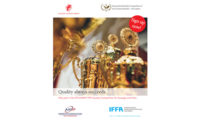Breakdown of how the meat is judged by German Butcher’s Association
In this video, Gero Jentzsch of the German Butcher’s Association gives a detailed breakdown of the judging criteria at IFFA and discusses how the German Butcher’s Association judging differs from the American Association of Meat Processors.
Sam Gazdziak: We are here with Gero Jentzsch with the German Butcher’s Association. We’re talking about the IFFA Quality Competition here, so we’ve got a copy of the form here that the judges are using, all in German so unless you can read German, it won’t make a lick of sense to you, but could you explain some of the things that the judges are looking for?
Gero Jentzsch: We start off assuming it is a perfect product, which has a 50 point credit, and we are looking for flaws to take off of this 50 point credit. We do so with four categories here. They are basically more or less identical to those that AAMP uses in their product testing. We have Category One, which [is for] outer appearance. Second [category] is if you cut the product, the appearance of the cutting surface. Third category is texture. You put it in your mouth and chew it, and fourth of course is smell and taste.
For every category, our judges are working from the outside to the inside and look for flaws. For example, a classic flaw in Category One would be a burst casing. [More examples include] when you have a burst casing or a ripped casing or you have little specks from your smokehouse or the brine is not clear but milky or the casing is detached from the filling. You look at the product and check through these. For example, if there is a speck on the casing, if it is not a tiny speck… the judges have some leeway there if it is a serious flaw or a lesser flaw, they can deduct one or two points.
In this category, there is a multiplier down there, [which is] by one, so you multiply the one by one. That will of course take off one point of your 50. The more you go to the inside, the more important aspects of the sausage or the meat, you have different multipliers. For example, if you cut it on the inside and the inside doesn’t look good, you deduct one point here and have a multiplier by three. Consistency by two multiplier. For taste and smell, you have a by four multiplier. For example, here if there is rancid taste, and rancid is a severe flaw. You cannot take off one [but must] take off two or three, so this is a very severe flaw if you have a rancid taste of your meat product. You deduct two at the minimum and you have to multiply it by four, which means you take off eight points of your initial 50 credit.
If you see this legend here, if you have a flawless product where nothing is taken off the 50 [points], you get a gold medal. If you take off one [to] five, you get a silver medal, and if you take off up to 10, you get a bronze medal. So if you take off eight here [for rancid taste], you already won’t be able to get a gold or silver medal, you have a bronze medal. If there is any other flaw here that will exceed [the 10 points] and you go below 40, the product has failed altogether. No certificate, no award.
The idea in this kind of testing is that you can basically test any kind of sausage, any kind of meat product with the same testing sheet. We have only three testing sheets. One for sausage, one for ham and one for other meat products. These flaws obviously apply to different kinds of sausage, so this is the way we are different than the American Association of Meat Producers. The American way of testing products is they have many more classes, and we expect people to send in a perfect product or what they think is perfect. Our judges are looking for smaller or bigger flaws and deducting points.
To hear the whole interview with Gero Jentzsch, please click on the video above.
Looking for a reprint of this article?
From high-res PDFs to custom plaques, order your copy today!





